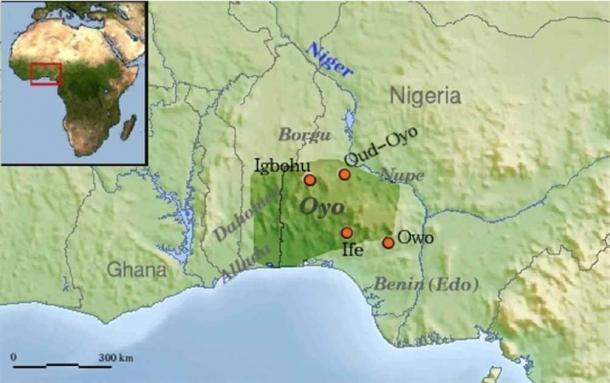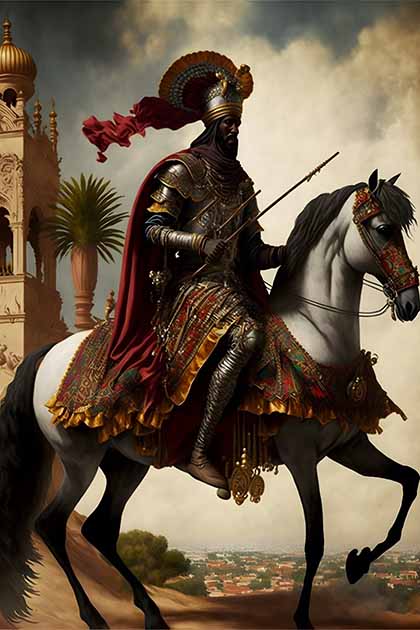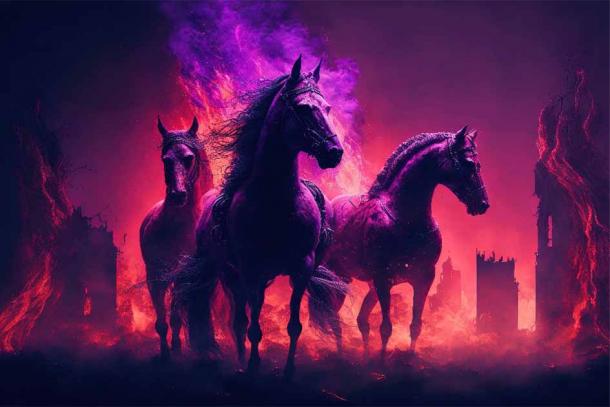The Horsemen of Oyo were legendary warriors who served the Oyo Empire of West Africa. Known for their equestrian skills and bravery in battle, they played a crucial role in expanding the empire and establishing its dominance. The Horsemen were also respected for their intelligence and wisdom, making them valuable assets to the Oyo royalty. Their legacy continues to inspire pride and respect among the Yoruba people, reminding us of the rich history and cultural heritage of the Oyo Empire.
The Horsemen of Oyo: Africa’s Greatest Military Unit
Records from the early eras of the Oyo Empire are sparse but it has been estimated that the Empire was first founded in around 1300 AD by the Yoruba (a West African ethnic group). The Yoruba people were a highly organized and sophisticated society, led by Oranmiyan, the first oba (king) of the Oyo Empire.

A carved wooden male figure with headdress from the Oyo Empire (17-19th century AD) in what is today southern Nigeria. Height: 28.5 cm. (British Museum/ CC BY-NC-SA 4.0 )
The empire’s capital was located in the city of Oyo-lle. As the empire rose to dominance, the capital became famed for its impressive architecture, wealth, and powerful military. The Oyo Empire revolved heavily around its military.
The Oyo Empire was led by a king known as the Alaafin, who was supported by a council of chiefs and a powerful army. The Alaafin had to be careful. The Yoruba military had strong values and allowing one’s sub-chiefs too much independence often led to revolt.

A map of the Oyo Empire which flourished in what is today southern Nigeria from the 17th to 19th century AD. (Rollebon/ CC BY-SA 3.0 )
Over time the Oyo Empire grew to become the largest Yoruba-speaking state and became one of the most politically important states in the whole of Western Africa . By the late 18th century, the empire held massive influence over not just most of the other Yoruba-speaking kingdoms but most of the nearby African states in general.
The empire’s rise has been put down to the Yoruba people’s impressive organizational and administrative skills. These skills led to massive successes in trade as Oyo was a center for Trans-Saharan trade . The kingdom specialized in the trade of salt, leather, kola nuts, ivory, cloth, and slaves. Its most famous commodity, however, was its excellent horses. The Yoruba craftsmen of metropolitan Oyo were also known for their craftsmanship, especially in ironwork.
All this trade made the Oyo Empire a rich one. This wealth was consolidated by the taxes it imposed on tributaries. For example, one tributary alone, the Kingdom of Dahomey , brought in around a million U.S. dollars a year. So, what did the Oyo spend all this money on? The military of course.
Utilizing the Horsemen of Oyo
Since the Oyo Empire made much of its income from taxing its tributaries, it needed to continuously field a powerful army. Oyo’s army had a natural advantage, the empire’s main geographic focus being north of the forests meant the empire enjoyed easier farming, which meant steady population growth. Steady population growth made it much easier to consistently field a large army.
The Oyo Empire was also entrenched in military tradition and had a do-or-die approach to conflicts. It was famed, not just for the professionalism and honor of its officers, but for their ferociousness. Victory was obligatory, defeat meant suicide.
And the military’s crown jewel was its cavalry. The biggest advantage the Horsemen of Oyo had was the simple fact they rode horses when most of the armies they faced had no cavalry to speak of. This gave them much greater speed and mobility that was unmatched by any other force in West Africa.
The military leaders knew that other armies feared the horsemen and wisely utilized them. The Horsemen of Oyo were known for their elaborate and impressive battle attire. The uniform consisted of brightly colored robes and headdresses while their horses were adorned with feathers and other decorative items. This made them into a striking visual spectacle that was hard to miss and the sight of the Horsemen of Oyo charging into battle was said to have been both terrifying and awe-inspiring. These visuals were backed up by their armaments. The Horsemen were usually equipped with lances, swords, and a shield. Without his horse, the horsemen weren’t much use and so the horses were heavily armored.

The advantage over enemy armies was their cavalry. (Representative image of Blackamoor warrior). ( Lipones /AdobeStock)
The Horsemen of Oyo were involved in many of the major battles fought by the Oyo Empire and their reputation as skilled and fearsome warriors continued to grow over time. Known for their courage and tenacity on the battlefield, if one looks at the history of Oyo’s military successes the horsemen played a major role in most of them. The Horsemen of Oyo were considered to be the backbone of the Oyo army and their contributions to the empire’s military success cannot be overstated.
Weaknesses
This isn’t to say that the horsemen of Oyo were invincible, they had the same weaknesses as the cavalry of any other nation. It can also be argued that the Oyo military relied too heavily on the horsemen at times, slowing the evolution of the Oyo’s military.
A good example of this is the Dahomey wars which began in 1728 when the Oyo empire invaded the Kingdom of Dahomey (which had become a growing threat to the Oyo). On paper, it looked like an easy victory for the Oyo. They’d been raiding southward since as early as 1682 and, up until attacking the Dahomey, no one had put up much resistance against the fearsome Horsemen of Oyo.
The Dahomey had no cavalry, which made the Oyo overconfident. What they did have, however, were guns, something the Oyo hadn’t branched into yet.

Horses of the Oyo cavalry were not used to sound of gunfire during the Dahomey battle. ( ReisMedia/AdobeStock)
The horses of the Oyo cavalry weren’t used to the sound of gunfire. Every time the Dahomey warriors fired, it terrified the horses and prevented their deadly charges. The Dahomey army also built special fortifications like trenches that halted the Oyo horsemen and forced the Oyo to use their infantry instead. While the Oyo were eventually successful, the fighting was much more difficult than they had expected. They had been forced to rely on reinforcements for the first time in centuries and it took 11 invasions until the Dahomey kingdom was finally completely subjugated in 1748.
The Oyo military waited until the 19th century to adopt guns. In the meantime, they continued to utilize their cavalry to beat back their neighbors and carry out conquests over great distances but their refusal to evolve with the times can be said to be a point of weakness in an otherwise powerful military.
Death and the King’s Horseman
The legacy of the Horsemen of Oyo continues to this day, and they are remembered as one of the greatest military forces in African history. Their legacy resulted in the writing of Death and the King’s Horseman , a famous play based on a real event in Nigerian history during the time of British colonial rule. The play was written by Wole Soyinka, a novelist, poet, essayist, and autobiographer who was born in Abeokuta in southwest Nigeria in 1934.
Soyinka wrote the play in 1975, upon returning home to a newly independent Nigeria, after studying theater in the UK. After returning home he became obsessed with his Yoruba heritage which led to his writing a play featuring the famous Horsemen of Oyo.
The Story
Death and the King’s Horseman is set in the early 1940s, long after the Kingdom of Oyo’s zenith. It follows Elesin Oba, the king’s horseman. Historically, the Horsemen of Oyo weren’t just revered warriors. They were also respected for their wisdom and tactical minds. As such it was normal for members to make their way to the royal court where they acted as advisors. It was common for an Oyo king to have a right-hand man who hailed from the cavalry, his horseman. Yoruba tradition dictated that when the king died his horseman must commit suicide before the king was buried so that his spirit could lead the king into the great beyond.
The first half of the play follows the life-loving Elesin just after the death of the king. He is making the most of his last day on Earth when at the last minute he is approached by the English colonial administrator, Simon Pilkings. Pilkings has little respect for local customs and intervenes, believing Elesin’s planned suicide to be illegal and unnecessary.
This results (in the play) in catastrophe for the people of Oyo. The local people believe the king’s spirit will now be doomed to wander the Earth for eternity, bringing untold suffering to his people. The locals blame Elesin alongside Pilkings, believing him to be selfish and too attached to the Earth to fulfill his sacred duty.
The play ends in tragedy. Elesin’s son, Olunde, returns from abroad where he has been studying medicine. He takes on his father’s responsibility and commits ritual suicide in his father’s stead to restore his family’s honor. A despondent Elesin then kills himself, condemning his soul to an eternity of suffering in the next world.
Impact of the Play
The play was massively successful and created massive global interest in Nigerian culture. It also played a key role in enlightening its audiences as to the effects of colonialism on ethnic groups in Africa.
Within Africa, the play brought on a cultural revival through its focus on Yoruba culture, language, and proverbs. Its effect was so great that the play was added to school syllabi all over Africa, especially in Nigeria. Once proud parts of West African history, like the Horsemen of Oyo, were once again remembered.
Conclusion
In conclusion, the Horsemen of Oyo were a legendary group of warriors who made a lasting impact on African history. Their reputation as fearless riders and skilled fighters was well-deserved, and their contributions to the expansion and dominance of the Oyo Empire were significant.
Today, thanks to works like The King’s Horseman, their legacy continues to inspire pride and respect among the Yoruba people, serving as a reminder of the rich history and cultural heritage of the Oyo Empire.
Hopefully, future artistic works will continue the legacy of artists like Soyinka in teaching people across the globe about Africa’s rich and fascinating history. A history that was obscured for far too long due to the combined effects of colonialism and racism.
Top image: Horsemen of Oyo charging into battle was said to have been both terrifying and awe-inspiring. Source: ( djfdez by Adobetock)
By Robbie Mitchell
 RSS Feed
RSS Feed













 March 2nd, 2023
March 2nd, 2023  Awake Goy
Awake Goy  Posted in
Posted in  Tags:
Tags: 
















